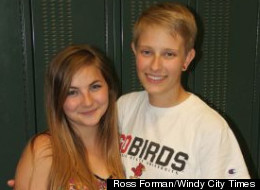Before I get into my weekly blog, I need to thank author Charlie Cochet for having me over to The Purple Rose Tea House earlier this week, and Rainy Kaye for hosting a really fun Author vs. Character interview for Werecat.
Meanwhile, in my non-writer’s life, I spent a lot of this week working on a talk for social workers and school counselors called: “The Brave New World of Growing up LGBT: Do I Say I Do?”

Lesbian couple Amber Lynn Phillips and Ola Wolan were crowned Prom Queen and King at a Chicago high school this past June.
I was asked to address how things have changed for LGBTs, and what the implications are for adults who work with them in schools and colleges and mental health settings.
I used to get asked a lot to speak on that topic. I worked for eighteen years at an organization called Long Island Crisis Center, which is on the front-line of teen suicide prevention and the region’s top advocate and resource for LGBT teens. Many times in conversations with colleagues and friends and even strangers, I get asked:
“Isn’t it easier for young people today?”
And, “Haven’t things gotten better?”
My talk was basically a response to those questions. In retrospect, I think a better title for the presentation would have been: “The Pride and Paradox of Growing Up LGBT.” I’ll try to sum up what I talked about.
Things have gotten better for LGBT teens. Public attitudes are steadily improving. Over forty percent of Americans believe there’s “nothing wrong” with homosexual relationships. Forty years ago, only ten percent of Americans responded in the same way. This is according to the General Social Survey of the National Opinion Research Center.
According to the Pew Research Center, the young adults who make up the Millennial Generation (those born after 1980) are much more accepting of LGBTs than the generations before them. In a 2013 study, seventy percent of ‘Millennials’ supported same-sex marriage. There is growing acceptance across all generations.
Legal rights have been realized in many areas of the country. Thirty-one states and territories have enacted laws that protect LGBs from discrimination in employment. Twenty of those include “gender identity or expression” as a protected category.
And of course, we now have federal recognition of same-sex marriages.
LGBTs are breaking ground in the media. From popular TV portrayals like the Fox series Glee, to professional athletes like NBA player Jason Collins coming out, to high profile politicians like lesbian NYC Council Speaker Christine Quinn, it feels at times that coming out is no longer a problem for public figures.
I think the greatest progress is happening in schools. In many suburban and urban areas of the country, it is now the norm, not the exception, for high schools to have a Gay/Straight Alliance as one of their student clubs. Many middle schools have established GSAs. There are stories of lesbian couples and gay couples being voted Prom King and Queen, like the photo at the top of this post.
If you want more evidence that things have gotten better for youth today, there is research that indicates that the average age for a young adult to come out is sixteen years old. That’s in contrast to an average age of twenty-five years old back in the early 90s.
Yet, there are also indicators that growing up LGBT remains frightening, and lonely, and in some cases deadly.

Mark Carson, who was verbally gay-bashed in NYC’s Greenwich Village and shot to death, one of 30 assaults on gay men recorded by the NYPD so far this year.
While the rights of LGBTs are being debated in the media, and regressive legislation is still happening in many parts of the country, young people are exposed to awful, demeaning rhetoric from politicians and religious leaders. The TV ad campaign for California’s Prop 8 is one example.
Gay boys in elementary school and middle school and high school are being viciously bullied. There have been at least two dozen high profile gay teen suicides across the country since 2011, including seventeen-year-old Carlos Vigil who just this past Saturday posted a suicide note on Twitter.
Is it easier for young people growing up LGBT?
Yes and no. In the midst of the country’s evolving attitude toward sexuality and gender expression, it’s hard to draw conclusions. It’s hard for LGBT teenagers to figure out where they stand in the eyes of their peers, their families and society.
They receive paradoxical messages.The mainstream media says it’s OK to be yourself; everyone should take pride in who they are. Yet, anti-LGBT hate, defamation and violence are still vicious undertones in our culture. They burst out at us on darkened city streets, political TV ads, Twitter feeds, and blog comments.
Pulled and pushed by pride and paradox, teens are making decisions as best they can about coming out. And they’re experiencing a variety of outcomes. Support and celebration. Shame and hurt.
One thing we can do is help young people navigate young adulthood safely. It might sound like being able to come out at sixteen years old (and even younger) is great. But a challenge that those of us who came out older never had to face was the stress of being out and visible at such a young age. There isn’t much life experience to draw on. The ability to cope and problem solve complex situations develops over time. For some teens that stress feels overwhelming and never-ending, and it seems as though there’s only one way to make the pain go away.
